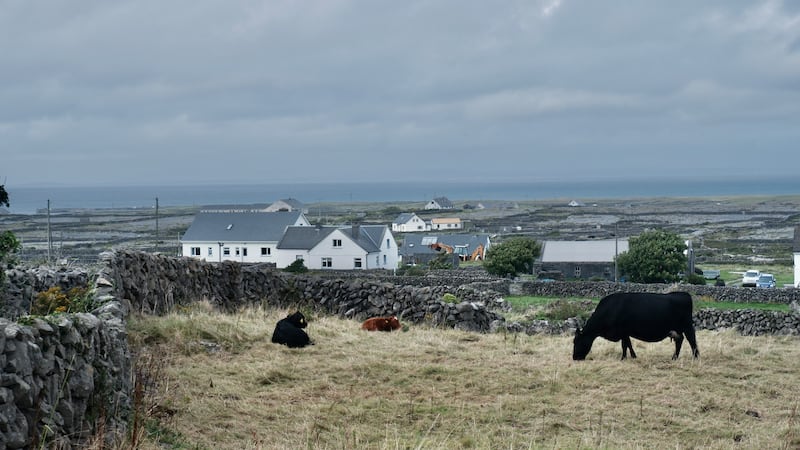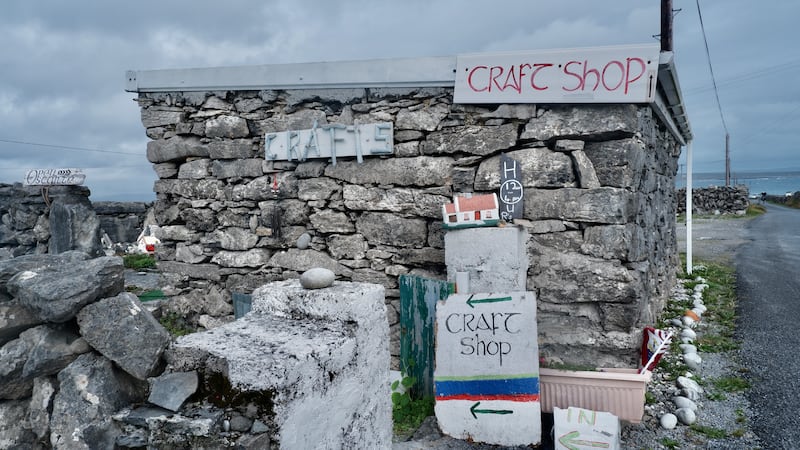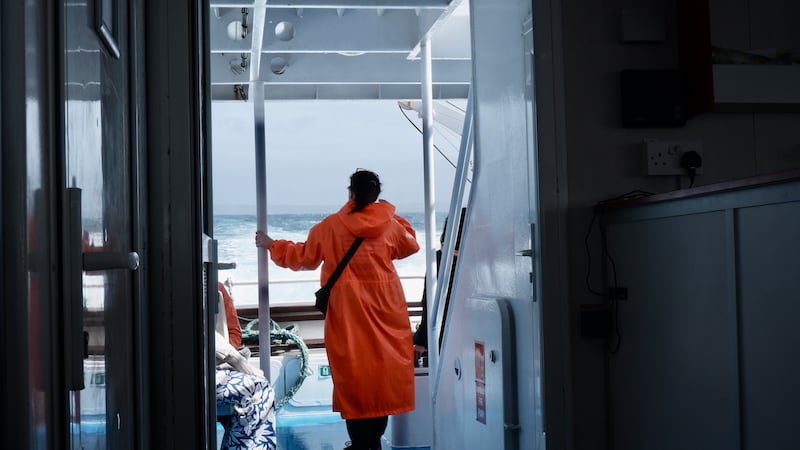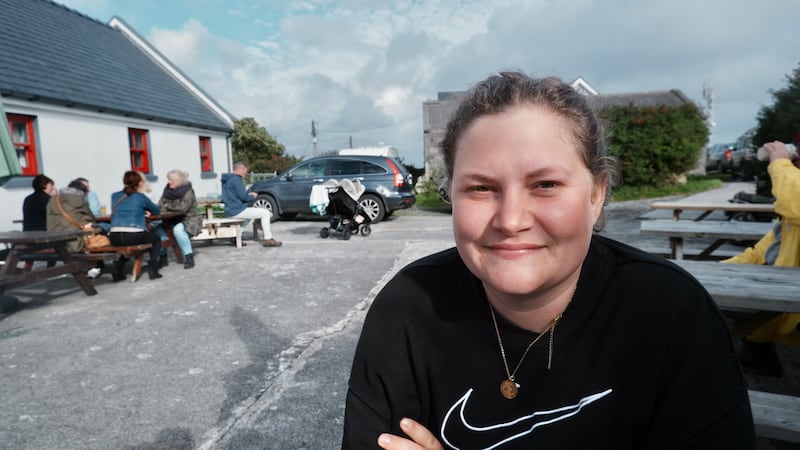Look one direction off Inis Meáin at night and you’ll see the lights of Galway city glittering in the distance, but if you look in the other direction, you’ll never see the sky so full of stars. The only sound you can hear is the wind whistling through the trees and, somewhere across the island, a dog barking.
It’s this kind of peace and quiet the locals cherish.
“If you’re into nature at all, it’s wonderful. Some people will say there’s nothing here, but in fact, there is everything here. We are rich in nature,” says Juda Lynch, a native of the island.
Lynch loves to go down to the shore after a storm to collect driftwood. “If there’s a storm, I’ll always go to check what it brought me. It’s like going shopping for me,” she laughs.
READ MORE

Inis Meáin is the middle of the three Aran islands, and receives far fewer visitors than Inis Mór and Inis Oírr on either side of it, something the locals would be happy to see remain that way. It is the smallest of the Aran Islands in terms of population – 184 in the latest census – and predominantly Irish-speaking.
Lynch grew up here at a time when there was no secondary school, so she went to boarding school on the mainland like many of her peers. After that, she spent some time in Dublin, and then San Francisco, where she met her husband, a Kerry man.
“We lived in Kerry and had five children. Those were happy days until he became ill. That was the turn of my life. I came back to the island nine years ago. I’ve never looked back since,” she says.
People passing by after a swim come by and chat. And they might even buy something
— Juda Lynch
Her grandchildren love visiting her on the island. “Often, children will talk about how bored they are, but they never use that word here. Take a child down to the seashore and they can be there all day looking at the little fish, peering into the water, and playing. Simple things like that. We can walk the road alone, there’s no crime, and we can just pick berries and observe nature”.
Lynch opened a shop five years ago where she sells crafts “passed down to me from generations”, she says.
She specialises in Aran jumpers and the crochet shawls that women on the island wore long ago.
“We saw it being done. It was going on around you so you picked it up that way. It’s a form of meditation as well,” she says.
The shop is “a place people come to congregate” on the island.
“People passing by after a swim come by and chat. And they might even buy something,” she jokes.

Lynch, like others on the island, worries about the effects of climate change but she tries to remain optimistic.
“This is my home and the whole island is like my garden. I like to protect it from being abused. We still have the bees and butterflies and even different wild birds coming here now than what I saw growing up,” she says.
There is also a swan that visits Inis Meáin about once a year, like the island’s “own version” of Fungie the dolphin, famous in Dingle.
The swan couldn’t be spotted last weekend on the island, though there was plenty more to see, including the stone ringfort monuments, and Teach Synge, a 300-year-old restored cottage that houses a museum dedicated to the life and work of the famous playwright John Millington Synge.
But not before a ferry from Doolin, across fairly choppy waters, after which a local man pulls up at the pier in a 14-seater minibus, offering any new arrivals a lift into town.

Taking a walk along the island’s trails, the sight of wildflowers blooming everywhere is breathtaking.
“You couldn’t live in a more idyllic place,” says Tárlach de Blácam, who runs a knitwear business on the island.
The community of the island has lived and farmed there for centuries, and are supported through schemes such as the AranLIFE project, supported by the Department of Heritage and the Gaeltacht, among other partners.
The three Aran islands are of such high value for nature that more than 75 per cent of the land area has been legally designated as Natura 2000 sites under European legislation. Projects like this aim to help farmers in continuing practices handed down over generations, in order to preserve the limestone pavements and orchid-rich grasslands.
This is “very encouraging”, de Blácam says, but he is “pessimistic about something else”: the future of the Irish language.
De Blácam was born in Dublin, but moved to the island 50 years ago.
“I did a degree in Celtic languages and my professor sent me here to learn Irish. I just loved it here. I met my wife, a native, and moved here,” he says.
“There was no electricity or running water at the time. Things were very basic. The islands were left behind basically. The ESB refused to supply electricity to the island then, saying they couldn’t afford it or it wouldn’t be economical,” he says.
He was involved in community development, helping to get the runway completed for the air service, and doing some pier works, as well as setting up his knitwear company in those early days.
People were leaving the island in their droves then, and young people were unable to see a future for themselves in such conditions.
But the richness of the Irish language was what encouraged De Blácam to stay.
There’s a difference between a cúpla focal and the richness of vocabulary the older people had here
— Tárlach de Blácam
While infrastructure is gradually improving, and the island now has both a primary and secondary school, which has “made life less traumatic than having to send your kids away to boarding school on the mainland for months at a time”, the language has been “diluted” in recent years, he says.
“The revival movement of the language will always be there but there’s something being lost that can never be replaced. There’s a difference between a cúpla focal and the richness of vocabulary the older people had here,” he says.
Nonetheless, islanders have “a positive, can do attitude” towards life. “It’s because you really have to improvise and find a way to do things if there’s a problem. It makes you very independent,” says de Blácam.
Their focus at the moment is on resolving issues with the island’s ferry service. Passenger ferry services are “not a problem,” operating most days year round, but the new pier, built a decade ago, remains unfinished, and makes it impossible for the “enormous” cargo vessel to get in.
“We’ve been banging away with the government and council to try to get the job finished and we’re being largely ignored. It’s challenging, to say the least,” he says.
The guards come around maybe every few weeks and look around. But I still never lock my door and I think most people don’t
— Publican Páraic Ó Flaithearta
Páraic Ó Flaithearta, who owns the island’s only pub, Teac Ósta, agrees the cargo service is a big issue for people on Inis Meáin.
“It’s not always dependable,” he says, adding that as a result, the pub can “sometimes be left without some of the drink or food”.
The island doesn’t have a fire service, or a full-time doctor, but there is a public health nurse on call for emergencies. The number is advertised at the entrance of the church, where there is also a printed timetable for the days the bank operates, and information about the library and ferry service.
“The guards come around maybe every few weeks and look around. But I still never lock my door and I think most people don’t,” says Ó Flaithearta.
This trust is evident when a woman I spoke to at the pub left all her things at the table – handbag, wallet, keys, sunglasses – while she popped home to grab a coat.
“You’d know everyone, there’s a real sense of community. It’s a small place, and we all depend on one another really,” says Ó Flaithearta says.

That’s what Ciara Ní Ríain Zimmermann loves about coming here. She now lives in Germany (her mother is Irish, and her father German) and spends several weeks a year on Inis Meáin, after going to school here as a teenager.
“When I was 11 we moved here as a family for a year. The following year, I moved here on my own and stayed with a bean an tí,” she says. She continued her schooling on both Inis Meáin and Inis Oírr until her Leaving Certificate.
Ní Ríain Zimmermann has a “strong love” of the Irish language, which she and her siblings began learning when they were “teeny tiny” thanks to their German dad, “who believed it was important for us to know our own heritage”.
“We’re here every year now for our summer holidays as our mum and dad bought a cottage in 2001,” she says. “The nice thing is, it doesn’t matter how long it’s been since you’ve been back, once you’re here, everyone will welcome you and is happy to see you.
“You can stick to yourself if you want your peace of mind, if you want to meet people you know where to go, but regardless everyone will always be looking out for you.”
At night, when the full moon lights up the whole sea, it’s just like a giant light bulb in the sky
— Ciara Ní Ríain Zimmermann
The small population of the island means “you see the same people walking the roads at the same time every day, and if they’re not there, you’ll wonder what’s wrong”, she says.
There is “no place” quite as beautiful as Inis Meáin, she adds.
“Going out to the cliffs and seeing the sun going down in the evening is the most beautiful light you could ever see. And at night, when the full moon lights up the whole sea, it’s just like a giant light bulb in the sky, it really shimmers and reflects over the water and it’s just beautiful”.
When you come here, you can “really switch off and relax”, she says.
No matter who you speak to on Inis Meáin, from the pub owner, to the craftspeople, or those who only reside here during the summer, all use one word to describe island living: “Freedom.”


















